 In addition to serving as the reproductive organs of flowering plants, flowers have long been admired and used by humans, mainly to beautify their environment but also as a source of food..
In addition to serving as the reproductive organs of flowering plants, flowers have long been admired and used by humans, mainly to beautify their environment but also as a source of food..Flower specialization and pollination
Further information: Pollination syndrome
Flowering plants usually face selective pressure to optimise the transfer of their pollen, and this is typically reflected in the morphology of the flowers and the behaviour of the plants. Pollen may be transferred between plants via a number of 'vectors'. Some plants make use of abiotic vectors — namely wind (anemophily) or, much less commonly, water (hydrophily). Others use biotic vectors including insects (entomophily), birds (ornithophily), bats (chiropterophily) or other animals. Some plants make use of multiple vectors, but many are highly specialised.Cleistogamous flowers are self pollinated, after which they may or may not open. Many Viola and some Salvia species are known to have these types of flowers.
The flowers of plants that make use of biotic pollen vectors commonly have glands called nectaries that act as an incentive for animals to visit the flower. Some flowers have patterns, called nectar guides, that show pollinators where to look for nectar. Flowers also attract pollinators by scent and color. Still other flowers use mimicry to attract pollinators. Some species of orchids, for example, produce flowers resembling female bees in color, shape, and scent. Flowers are also specialized in shape and have an arrangement of the stamens that ensures that pollen grains are transferred to the bodies of the pollinator when it lands in search of its attractant (such as nectar, pollen, or a mate). In pursuing this attractant from many flowers of the same species, the pollinator transfers pollen to the stigmas—arranged with equally pointed precision—of all of the flowers it visits.
Anemophilous flowers use the wind to move pollen from one flower to the next. Examples include grasses, birch trees, ragweed and maples. They have no need to attract pollinators and therefore tend not to be "showy" flowers. Male and female reproductive organs are generally found in separate flowers, the male flowers having a number of long filaments terminating in exposed stamens, and the female flowers having long, feather-like stigmas. Whereas the pollen of animal-pollinated flowers tends to be large-grained, sticky, and rich in protein (another "reward" for pollinators), anemophilous flower pollen is usually small-grained, very light, and of little nutritional value to animals.

Types Of Flowers |
Many millenniums flowers personify beauty at people, pleasure and perfection of the nature. Flowers are giving to everybody, it does not matter who you are rich or poor, they give you that wonderful world, in which you feel yourself happy. Therefore people always tried to decorate with these surprising gifts of the nature not only celebratory and gala days of the life, but also everyday lives, which, as is known people have more even more full to feel pleasure of short-term life on the guilty Earth. It seems that mother-nature has tried and has presented us these wonderful creations which a lot of millenniums ago bring in our life beauty, pleasure, and giving us good mood and emotional health at any time of the year. In opinion of scientists there are more than 270 000 versions of colors. And each flower in his own way is beautiful and unusual and bears in itself a part of pleasure, to do our life more happier. At all nations of the world flowers associate with heat, sun, spring and pleasure. And it is not important winter in the street or summer, autumn or spring. Flowers always remain symbols of good mood and wonderful season - spring and summer. Each flower, is shrouded by illusive and mysterious aura, and that magic mood with which it presents all people without exception, whether it is a man or a woman, a small child or an elderly person. |

http://www.roboimages.com/image/ri28473/36.gif
en.wikipedia.org/wiki/Flower




 Photograph by James L. Stanfield
Photograph by James L. Stanfield


